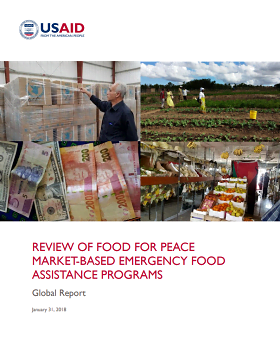Review of Food for Peace Market-Based Emergency Food Assistance Programs Global Report
Efficient and effective use of humanitarian funds is critical to meet the emergency needs of as many people as possible, especially as emergencies in developing countries have become more numerous, complex, and protracted. The United States Agency for International Development (USAID) Office of Food for Peace (FFP) is the largest donor providing funds for emergency food assistance. Since 2010, FFP has used a variety of approaches to meet emergency food security needs quickly and costeffectively1 via U.S. sourced in-kind food aid or through market-based modalities such as cash transfers, vouchers, and locally or regionally purchased food (LRP). Emergency Food Security Program (EFSP) and Title II Section 202(e) and Enhanced Section 202(e) funds have also been available for complementary services designed to support the primary food assistance interventions.2
This review of FFP market-based emergency programming (MBEP) activities from 2010-2016 has four objectives: (1) document the history and evolution of FFP market-based emergency assistance; (2) review program design and implementation processes; (3) analyze program cost-efficiency trends;3 and (4) qualitatively assess the effects of FFP projects on local economies and market actors.
The review drew on an expansive body of literature relevant to emergency food assistance programming; program documents from and Key Informant (KI) interviews of FFP and its implementing partners (IPs); an online survey, and seven case studies. The review presents an analysis of the broader system of emergency food assistance programming at FFP as well as seven field case studies. Case study country field sites were selected to represent ongoing FFP programming around the world and included a mix of slow-onset crises, acute crises, and regional emergencies.
Full case study reports are available separately:
Democratic Republic of Congo Case Study Report
Sierra Leone Case Study Report
Jordan/Turkey Case Study Report



